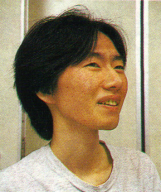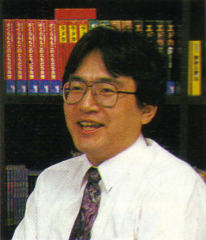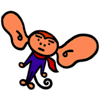Weekly Famitsu – September 9th, 1994
by: 8lackSphinx on 4/27/2020
Weekly Famitsu: That was one rough childbirth, wasn’t it? [laughs]
Malta: Yes, yes it was. [laughs]
Weekly Famitsu: Was it HAL or APE that handled most of the work developing the game?

Iwata: APE had more people working on it. We [HAL] worked on some of the overall system, but maps and scenarios take a lot more work than the system when it comes to RPGs.
Malta: Yeah. So in that sense you could say it was a bit more work for us [APE].
Iwata: But near the end of production we had everyone from APE come to our office in Yamanashi Prefecture. There was equipment only available in our offices at the time, and the scheduling worked out, so…
Malta: We’d basically camp out there for a week at a time.
Iwata: Our company has a meeting room with a view of Mt. Fuji through the glass panels, and that was the room that practically turned into a separate branch office for APE.
Malta: We’d completely taken over the whole place. [laughs]
Weekly Famitsu: So it was produced in a room with a view of Mt. Fuji? That must have felt great.
Malta: Yeah. We’d talk about how great it’d be to have an office in a place like that.
Iwata: A beautiful place like that is a good location for creating something, but life in the city is a lot more convenient.
Weekly Famitsu: When was the camp-out you’re talking about?
Iwata: It was from fall of last year [1993] until spring of this year [1994] that they were coming to our office regularly.
Weekly Famitsu: Of course Itoi would go too, as the scenario director?
Iwata: Yeah, he’d stop by from time to time. It provided some gossip for the neighborhood cafeterias. “Oh, isn’t that Shigesato Itoi? What’s he doing here?” [laughs]
Weekly Famitsu: Did people mooch him for autographs?
Iwata: Right in front of me, no less. [laughs]
Weekly Famitsu: When did the game come together as a completed product?
Iwata: Around mid-April is when we more-or-less had an RPG that wouldn’t embarrass us if we released it. But we’d already made everyone wait so long for it that we wanted to really see it through to the end, so we spent the next three months perfecting it. We originally thought it’d be ready in two months, though. [laughs] The standards really shot up during those last three months, so as a creator, the feeling of accomplishment changed.

Weekly Famitsu: I hear it turned out like the previous game, with how much freedom you had after the main programming was all ready. Did that make you devote even more attention to those parts?
Malta: We did. It was amazing, like a game for us in its own right. So there were some major final enrichments during those three months. We hadn’t yet done a full run-through by the time MOTHER 2 finally took shape, so we played it together as a staff. Then we found some places that weren’t going to work, so we made sure to polish it all up.
Iwata: There’d be a spot that we joked about how it’d be better in such-and-such a way and then two months later be set that way. I feel the staff made the game without compromising.
Malta: The slot machine in the desert is a perfect example.
Weekly Famitsu: Slot machine?
Iwata: It’s pretty far into the game, but there’s a slot machine just plopped right in the desert. We thought it’d be neat if the slots were actually playable, so we made it work.
Malta: And to top it off, it’s not that there’s a working machine—there are men in the shape of a slot machine who move around. That’s the kind of playful imagination you’ll find in the game.
Weekly Famitsu: Isn’t it hard to program the system to add things like that after the fact?
Iwata: Oh, absolutely. The bicycle near the beginning of the game, for example. We went through a ridiculous amount of trouble to work that into the system, you know. That was a hell of a hailstorm. We had to build all kinds of special provisions just to manage it. Any normal programmer would turn up their nose at it, though. But it was like a motto of ours to never do that. [laughs]
Malta: In that sense, APE really owes a lot to the team at HAL Lab. Even when we brought up some unreasonable, difficult-to-implement request, they never brushed it off by saying, “We can’t do it.”
Iwata: Once a programmer says they can’t do something, future games are done for. What we’re considering nowadays are ways for us to avoid that. Instead we think about how we, as producers, can clearly portray our thoughts and ideas to the recipient customer without saying “We can’t do that.”
Weekly Famitsu: What specific parts gave you a hard time?
Malta: I’d say the delivery man.
Iwata: There’s a special system for a delivery man in the game. One comes to bring you items you weren’t able to carry before, and one is a pizza delivery man. This is something that has to reach the player at any stage in the game. It was a really reckless idea—the delivery man can’t just pass through walls that the player can’t walk through, so we had to make him able to navigate the map for himself.
Malta: But the player had been able to play around and run away as soon as the delivery man appeared.
Iwata: Until we were able to take care of that part, we were wondering why the heck we were trying so hard. [laughs]
















